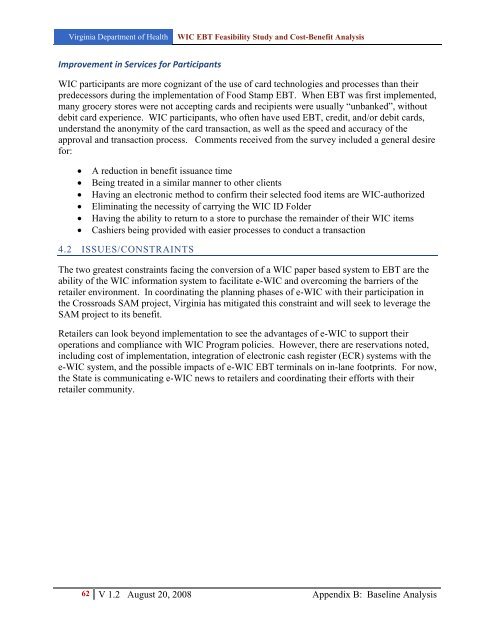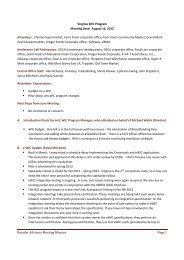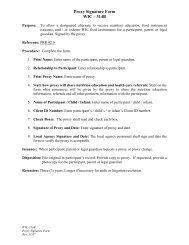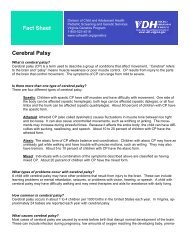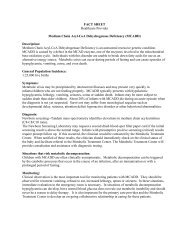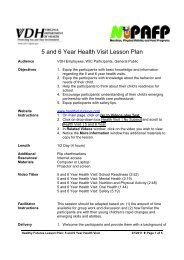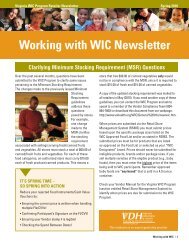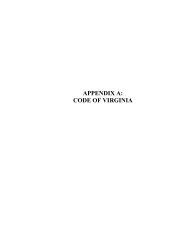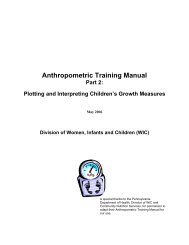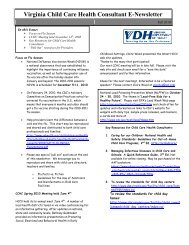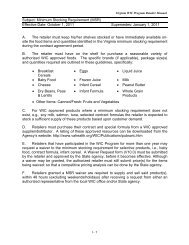WIC EBT Feasibility Study and Cost‐Benefit Analysis
WIC EBT Feasibility Study and Cost‐Benefit Analysis
WIC EBT Feasibility Study and Cost‐Benefit Analysis
Create successful ePaper yourself
Turn your PDF publications into a flip-book with our unique Google optimized e-Paper software.
Virginia Department of Health <strong>WIC</strong> <strong>EBT</strong> <strong>Feasibility</strong> <strong>Study</strong> <strong>and</strong> Cost-Benefit <strong>Analysis</strong><br />
Improvement in Services for Participants<br />
<strong>WIC</strong> participants are more cognizant of the use of card technologies <strong>and</strong> processes than their<br />
predecessors during the implementation of Food Stamp <strong>EBT</strong>. When <strong>EBT</strong> was first implemented,<br />
many grocery stores were not accepting cards <strong>and</strong> recipients were usually “unbanked”, without<br />
debit card experience. <strong>WIC</strong> participants, who often have used <strong>EBT</strong>, credit, <strong>and</strong>/or debit cards,<br />
underst<strong>and</strong> the anonymity of the card transaction, as well as the speed <strong>and</strong> accuracy of the<br />
approval <strong>and</strong> transaction process. Comments received from the survey included a general desire<br />
for:<br />
• A reduction in benefit issuance time<br />
• Being treated in a similar manner to other clients<br />
• Having an electronic method to confirm their selected food items are <strong>WIC</strong>-authorized<br />
• Eliminating the necessity of carrying the <strong>WIC</strong> ID Folder<br />
• Having the ability to return to a store to purchase the remainder of their <strong>WIC</strong> items<br />
• Cashiers being provided with easier processes to conduct a transaction<br />
4.2 ISSUES/CONSTRAINTS<br />
The two greatest constraints facing the conversion of a <strong>WIC</strong> paper based system to <strong>EBT</strong> are the<br />
ability of the <strong>WIC</strong> information system to facilitate e-<strong>WIC</strong> <strong>and</strong> overcoming the barriers of the<br />
retailer environment. In coordinating the planning phases of e-<strong>WIC</strong> with their participation in<br />
the Crossroads SAM project, Virginia has mitigated this constraint <strong>and</strong> will seek to leverage the<br />
SAM project to its benefit.<br />
Retailers can look beyond implementation to see the advantages of e-<strong>WIC</strong> to support their<br />
operations <strong>and</strong> compliance with <strong>WIC</strong> Program policies. However, there are reservations noted,<br />
including cost of implementation, integration of electronic cash register (ECR) systems with the<br />
e-<strong>WIC</strong> system, <strong>and</strong> the possible impacts of e-<strong>WIC</strong> <strong>EBT</strong> terminals on in-lane footprints. For now,<br />
the State is communicating e-<strong>WIC</strong> news to retailers <strong>and</strong> coordinating their efforts with their<br />
retailer community.<br />
62 V 1.2 August 20, 2008 Appendix B: Baseline <strong>Analysis</strong>


